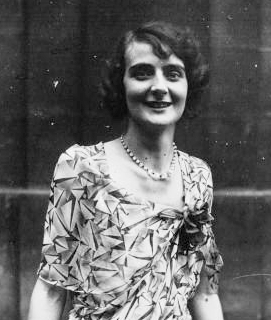Yvonne Desportes facts for kids
Yvonne Desportes was a talented French composer, writer, and music teacher. She lived from 1907 to 1993. Yvonne was born in Germany. Her father, Émile Desportes, was a composer, and her mother, Bertha Troriep, was a painter. She learned from famous teachers like Paul Dukas. In 1932, she won the very important Prix de Rome music prize. She also taught at the famous Paris Conservatoire and wrote many music textbooks. Yvonne Desportes created over 500 musical pieces!
Contents
Her Early Life and Learning
Yvonne started learning piano with great teachers like Yvonne Lefébure and Alfred Cortot. In 1918, when she was just 11, she began taking music classes at the Paris Conservatoire. She also studied at another music school, the École Normale de Musique, for three years. From 1925 to 1932, she attended the Conservatoire National Supérieur de Paris. There, she learned from many important teachers, including Jean and Noël Gallon, Marcel Dupré, Maurice Emmanuel, and Paul Dukas. You can see a picture of Paul Dukas's class below.
Winning the Prix de Rome
The Prix de Rome was a very important competition for young artists and musicians in France. Yvonne Desportes tried four times to win this prize. In 1927, she won the first prize in harmony, and in 1928, she won the first prize in fugue (a type of musical composition).
In 1930, she won the Second Grand Prix. A music critic named Paul Bertrand praised her music, saying it was "all delicacy, all femininity." In 1931, she won the Premier Second Grand Prix. It was a special year because two women, Yvonne and Henriette Puig-Roget, won top prizes in the same year for the first time ever!
Finally, in 1932, Yvonne Desportes won the highest award: the Premier Grand Prix. This was a huge achievement! Paul Bertrand said she had "a real sensitivity and a precious gift for dramatic expression." Winning this prize was especially remarkable because, at that time, it was not common for women, especially mothers, to achieve such high public honors in France. Yvonne's win showed her amazing talent and determination.
A Dedicated Teacher
While at the Villa Médicis in Rome, Yvonne met and married Ulysse Gemignani, who was also a winner of the Prix de Rome, but for sculpture.
After returning to Paris, Yvonne continued her teaching career at the Conservatoire. She taught harmony and then solfège (music reading and ear training) from 1937 to 1938. She even wrote her famous Leçons de solfège (Solfège Lessons) textbooks. In 1943, she became a full professor of solfège, and later, in 1959, she became a professor of counterpoint and fugue.
Yvonne Desportes composed a huge number of works, including 332 pieces for instruments, 159 vocal pieces, and 31 music textbooks. Her compositions included three symphonies, a requiem (a type of mass for the dead), and eight operas. Her music was influenced by older styles like the Baroque period, but also by the rich sounds of Russian composers and the harmonies of Ravel and early Stravinsky. Even though she was a busy composer and teacher, Yvonne also cared deeply about her family. When asked if anything was forgotten about her career, she once said, "yes, the part which relates to my sons: eleven and thirteen years old. And to my older daughter: seventeen years old."
Her Unique Composing Style
Yvonne Desportes had a great sense of humor, which she sometimes showed in her music. For example, in her piece Variations sur le nom de Beethoven for orchestra (1974), she used the letters of Beethoven's name to create musical notes. She also included hints of his famous 5th Symphony within her own melody.
Another funny piece is Pavane pour un timbalier dèfunt (Pavane for a deceased timpanist). In this work, singers have to make funny sounds like “tataralatatarasa…” and “tiguidiguiditatalota…” while a military drum plays. It's all punctuated by a funny interjection: “Scrogneugneu!” which means "Humph!"
She also used names to create music in her saxophone and harp duet, Une fleur sur l’étang (A flower on the pond). In one part, the letters of the name "Daniel Kientzy" are spelled out by the notes played by the saxophone and harp, both forwards and backwards!
Selected Works
Yvonne Desportes composed more than 500 musical pieces. These include operas, symphonies, ballets, concertos, chamber music (for small groups of instruments), and music for voices and solo instruments. Here are some of her selected works:
- La Foire aux Croûtes, 12 miniatures for percussion and piano (The Flea Market)
- Passionette: pour chant et piano
- La Danse De Xylonette
- Sonate Pour Un Bapteme
- Suite Italienne
- 20 petites pièces en forme d'études pour xylophone
- Sicilienne et Allegro, for horn and piano (1932)
- Trifaldin, ballet (1935)
- Le Rossignol et l'Orvet, opéra (1936)
- Les 7 Péchés capitaux, ballet (1938)
- French Suite for four Bb clarinets (1939)
- Maître Cornelius, opéra (1940)
- La farce du carabinier, opéra (1943)
- Ballade Normande, for horn and piano (1943)
- Variations symphoniques (1946)
- Improvisation, for horn and piano (1953)
- Concerto pour percussion n°1 (1957)
- Symphonie n°1 Saint-Gindolph (1958)
- Concerto pour percussion n°2 (1960)
- Voyage au-delà d'un miroir, pour 3 percussions (1963)
- Symphonie n°2 Monorythmie (1964)
- Vision cosmique, pour 3 percussions avec bronté (1964)
- Le Forgeur de merveilles, opéra (1965)
- Symphonie n°3 L'Éternel féminin (1969)
- Au-delà de la prière pour bronté et orchestre à cordes (1970)
- Sextuor La maison abandonnée
- Octuor pour quatuor vocal et quatuor à cordes
- Quatuor
- Quintette
- Ambiances pour soprano et 2 percussions
- 7 Poèmes abstraits pour chœur mixte et percussion
- 8 Pièces vocales pour soli, chœur et orchestre
- Les amis de toujours pour chœur mixte
- Des chansons dans la coulisse pour trombone et piano
- L'horloge jazzante pour saxophone et guitare
See also
 In Spanish: Yvonne Desportes para niños
In Spanish: Yvonne Desportes para niños




